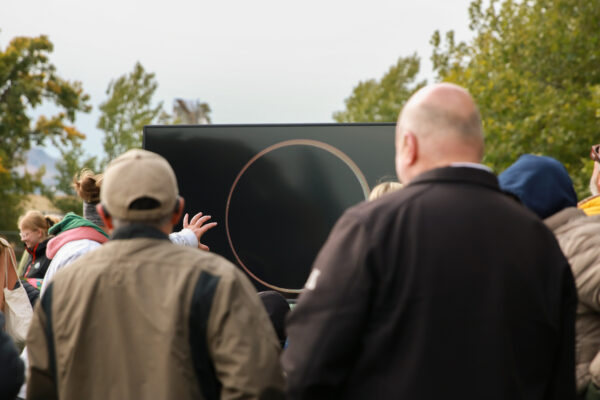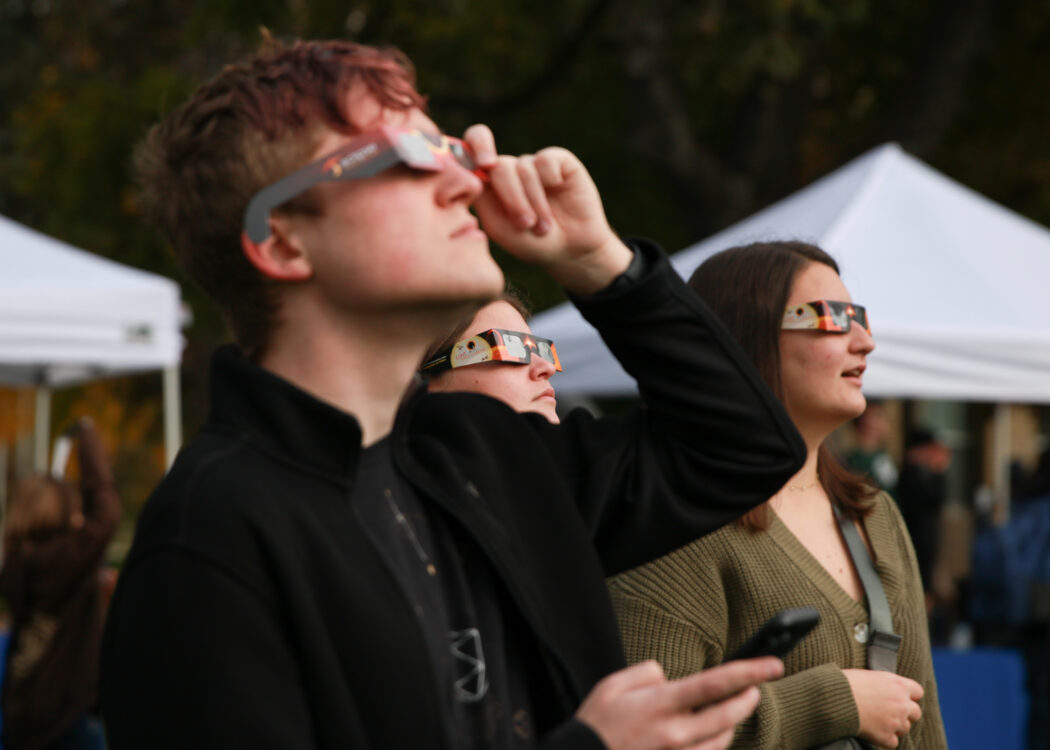Annular eclipse brightened the Quad
On Oct. 14, the moon’s shadow carved a path over cities from Eugene, Oregon to Corpus Christi, Texas. Some experienced upwards of four and a half minutes of near-totality, with eyes and telescopes turned upward for a glimpse at the ring of fire.
This isn’t the first time such an event has happened. Just over six years ago, the Great American Eclipse swept from the Pacific Northwest to South Carolina, but the path of totality missed Utah by 142 miles, instead passing Logan to the north, covering Idaho Falls. This time, however, Logan was luckier.
On October 14th, Logan was privy to a 89% totality, covering the valley in near-complete darkness, save for a small crescent of sunlight still visible. This is because unlike the 2017 eclipse, this one was annular.
Solar eclipses occur when the moon’s orbit aligns with the Earth, blocking the sun and leaving a shadow. Due to the moon’s orbital speed and five degree tilt compared to Earth’s solar orbit, eclipses are bound to happen somewhere at least twice a year, but no more than five times.
James Coburn, a professor of the USU Physics Department, described the reason not all eclipses are total.
“An annular eclipse happens when the moon is further away in its orbit,” Coburn said. “The moon is at the far side of its orbit, so when it crosses the sun, it won’t quite cover it up.”
By contrast, if the moon were nearer to its perigee, or closer to Earth, a total eclipse may have occurred.
Despite the fact the sun was partially obscured, you should never observe an annular eclipse without protective lenses, even at its maximum. Doing so can cause severe damage to the eyes, including retinal burns, or eclipse blindness.
As the weekend approached, people across the Southwestern US, Central and South America made plans. People sometimes cross state or even national boundaries for the chance to witness an eclipse in person.
Gabriela Alcaraz, a first-year student majoring in human biology, had plans of her own.
“I plan on watching “Twilight: Eclipse” with my cat, because I feel like it really ties into the whole event,” she said.
While some were content to watch the skies from home, others attended USU’s Annular Solar Eclipse Observation Event. A lively scene greeted visitors on the Quad, with dogs running through the grass and lenses facing the sky. There was just one problem. Clouds covering the sun.
While other parts of Utah viewed the start of the eclipse with a clear sky and beautiful, 70 degree weather, Logan’s view was blocked by mid-morning cirrocumulus, a sign of the changing seasons. The spectacle was temporarily rendered imperceptible to the naked eye, though using a solar filter sometimes helped with visibility.
However, this did little to dampen the atmosphere, as attendees explored the various booths, viewing the sun through an array of different telescopes and speaking with physics majors about the eclipse.
Anne Hedrich was impressed by the event’s flexibility.
“We’ve gotten to see quite a bit, and in a way, it makes you appreciate it even more,” Hedrich said. “I didn’t even realize that this would be such a big thing happening. I came up to check it out, and it was this big event. It was awesome. I hope lots of people had the chance to see it.”

People view a live stream of the annular solar eclipse from a telescope located in Valley of the Gods, Utah.
Running through the grass surrounding the crowds were groups of children, some of them playing games as they waited, others wide-eyed with wonder as their parents explained how the moon was blocking the sun’s rays. Abby Bernier, a senior studying wildlife ecology and management, made note of how the event catered to all age groups, rather than just university students.
“I thought it was really cool that USU did this,” Bernier said. “It definitely made it a great event for people who weren’t able to go down to southern Utah, and it’s great that they have all of these educational stations. They made it pretty kid-friendly. I’m really happy with how it turned out.”
Children and young families weren’t the only demographic to attend. Several groups of older citizens came as well, such as Visnja Taylor. Her group was ecstatic to see the clouds part just in time for the maximum, at 10:38 a.m.
“It was very exciting,” Taylor said. “It was very cloudy in the morning, then we came here just at the right time to see the crescent-moonish shaped sun, and now, we can see it really well with the glasses.”
Taylor had never seen an eclipse before, but for her, it was just as much about the people around her as it was with the sun.
“I think it’s very impressive how many people turned up,” Taylor said. “It’s very nice for the community. Well done to James and the Physics Department.”
Utah and Cache Valley will be visited by more eclipses. The next total eclipse to visit will be lunar, happening on the nights of March 13 and 14, 2025, and the next solar eclipse will be partial, occurring on January 14, 2029.
Logan won’t experience a total solar eclipse until well beyond our time, namely June 24, 2169, a little more than 145 years in the future.

